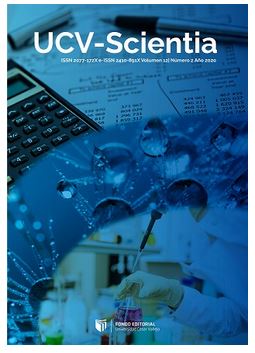Indirect evidence in the investigation of the crime of organized crime
DOI:
https://doi.org/10.18050/revucv-scientia.v15n2a3Keywords:
Circumstantial evidence, elements of circumstantial evidence, criminal investigation, evidence of the crimeAbstract
The fight against organized crime occurs with the treatment of circumstantial evidence, also known as indirect, circumstantial or conjectural evidence, the police and the prosecution are called to gather it and argue it at the stage of preliminary proceedings and preparatory investigation, it is difficult to face such scourge with direct evidence as occurs in common crime, therein lies the importance of the treatment of circumstantial evidence, in this context the investigation aimed to analyze the effects that circumstantial evidence has in the investigation of the crime of organized crime, Investigations Division of High Complexity, executed under a type of basic research, qualitative approach, hermeneutic phenomenological design and inductive method, under a sample of 8 specialists, using the interview guide instruments and documentary analysis sheet, arriving at the result that there is a weak treatment of the elements of the circumstantial evidence, non-existent criminal investigation doctrine linked to circumstantial evidence, the non-treatment of the evidence of the crime: evidence of the potential crime (linkage of the alleged perpetrator, capacity to commit a crime, motive and opportunity to commit a crime) and indications of the crime in action (preparatory acts: background; concomitant: product of the facts and subsequent: after the fact), these are effects and findings found regarding the non-treatment of the circumstantial evidence by the investigative police, as such, there is an impact on the truth of the facts, therefore, criminal investigation not in accordance with the standards of the newest Peruvian criminal process.
References
Arocena, G. (2020) ¿De verdad? Prueba, racionalidad y verdad en el procedimiento criminal. Zela Grupo Editorial.
Berrezueta G., y Guedes C. (2020) La prueba indiciaria en fase de investigación previa en el Ecuador. [Tesis de Abogado. Universidad de Guayaquil]. http://repositorio.ug.edu.ec/handle/redug/50391
Cáceres, R. (2022). La prueba por indicios en el proceso penal. Importadora y Distribuidora Editorial Moreno.
Corte Suprema de Justicia de la República. Sala Penal Permanente (2005). Recurso de Nulidad 1912-2005 Piura. Magistrado ponente Sivina Hurtado. https://img.lpderecho.pe/wp-content/uploads/2021/05/Recurso-de-Nulidad-1912-2005-Piura-LP.pdf
Corte Suprema de Justicia de República. Sala Penal Transitoria (2018). Recurso de Nulidad 2400-2018 Junín. Magistrado ponente Prado Saldarriaga. https://img.lpderecho.pe/wp-content/uploads/2020/04/R.N.-2400-2018-Jun%C3%ADn-LP.pdf
Corte Suprema de Justicia de República. Sala Penal Transitoria (2021). Recurso de Nulidad 1582-2021 Callao. Magistrado ponente Guerrero López. https://img.lpderecho.pe/wp-content/uploads/2022/05/Recurso-nulidad-1582-2021-Callao-LPDerecho.pdf
Corte Suprema de Justicia de República. Sala Penal Permanente (2013). Casación 626-2013 Moquegua. Magistrado ponente Neyra Flores. https://www.pj.gob.pe/wps/wcm/connect/b334ac0043b4e20682d8afd60181f954/CAS+626-2013+Moquegua.pdf?MOD=AJPERES&CACHEID=b334ac0043b4e20682d8afd60181f954
Centro UC Estudios Internacionales (2023). Riesgo Político América Latina. http://centroestudiosinternacionales.uc.cl/images/publicaciones/publicaciones-ceiuc/2023/Riesgo_Politico_America_Latina_2023.pdf
Comisión Interamericana de Derechos Humanos (2023). Impacto del crimen organizado en Mujeres, niñas y adolescentes. https://www.oas.org/es/cidh/informes/pdfs/2023/NorteCentroamerica_Mujeres_ES.pdf
Chaia, R. (2020). La prueba en el proceso penal. Hammurabi.
Devis, H. (2022). Teoría general de la prueba judicial. Editorial Temis.
García, P. (2010). La prueba por indicios en el proceso penal. Editorial Reforma.
Igartua, J. (2021). Indicios, duda razonable, prueba científica. Tirant lo Blanch.
Jacho, L. (2021) La prueba indiciaria en el proceso penal ecuatoriano. [Tesis de Maestría. Universidad Católica Santiago de Guayaquil]. http://repositorio.ucsg.edu.ec/handle/3317/16321
Lamas, L., y Lamas, G. (2020). La prueba indiciaria en el delito de lavado de activos. Editorial Lamas Puccio Abogados.
Miranda, M. (2012). La prueba en el proceso penal acusatorio. Jurista Editores.
Odar, G. (2021) La debida motivación en la valoración de la prueba indiciaria para la condena en relación con la presunción de inocencia en el Perú. [Tesis de Maestría. Universidad Señor de Sipán]. https://repositorio.uss.edu.pe/handle/20.500.12802/9103
Ortiz, A. (2022) La eficacia de la prueba indiciaria en el delito de lavado de activos en el Distrito Fiscal de Tacna, 2021. [Tesis de Maestría. Universidad César Vallejo]. https://repositorio.ucv.edu.pe/bitstream/handle/20.500.12692/101900/Ortiz_SAR-SD.pdf?sequence=1&isAllowed=y
Pabón, G. (2020). De la censura de indicios en casación penal. Grupo Editorial Ibáñez.
Pabón, G. (2017) Lógica del indicio en materia criminal. Grupo Editorial Ibáñez.
Pisfil, D. (2020). La prueba indiciaria en el proceso penal. Pisfil (Ed.), Prueba, verdad y razonamiento probatorio (1 ed., pp. 297-337). Editores del Centro.
Presidencia del Consejo de Ministros (2023). Decreto Supremo n.º 105-2023-PCM., por el cual se declara el Estado de Emergencia en los distritos de San Martín de Porres y San Juan de Lurigancho de la provincia de Lima del departamento de Lima y en los distritos de Sullana, Bellavista, Marcavelica, Salitral, Querecotillo, Ignacio Escudero y Miguel Checa de la provincia de Sullana del departamento de Piura.
Rua, G. (2022). Planificación de un caso penal. Ediciones Didot.
Downloads
Published
How to Cite
Issue
Section
License
Copyright (c) 2024 Ismael Edwar Arroyo Roca

This work is licensed under a Creative Commons Attribution 4.0 International License.
- Share — copy and redistribute the material in any medium or format
- Adapt — remix, transform, and build upon the material.
- The licensor cannot revoke these freedoms as long as you follow the license terms.
Under the following terms:
-
Attribution — You must give appropriate credit, provide a link to the license, and indicate if changes were made. You may do so in any reasonable manner, but not in any way that suggests the licensor endorses you or your use.
- No additional restrictions — You may not apply legal terms or technological measures that legally restrict others from doing anything the license permits.













